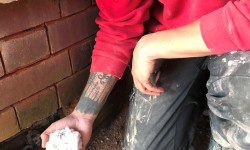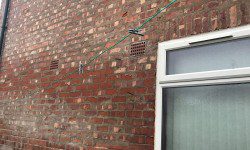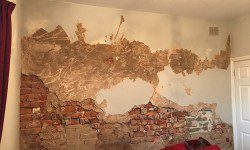Cavity wall insulation causing dampness?
Poor quality design and installation of retrofit insulation, coupled with defects such as poor pointing and cracked render in filled cavity wall buildings, can lead to major problems and early signs should not be ignored.
Watch the video - Retrofit Insulation
Householders affected by issues with damp should consider failed or compromised insulation as a possible cause. The retrofit insulation industry grew rapidly on the back of government subsidies, with property experts saying that some contractors have allowed standards to slip in the chase for grant funding.
The background
Before we look at the consequences, it is worth looking at how we reached our current position. The retrofit insulation industry has faced the same seemingly intractable problem many times. Insulation providers struggle to convince people to spend their own money on good quality, well designed and properly installed energy saving measures.
For almost two decades, the retrofit insulation industry has grown quickly with the ebb and flow of government inspired subsidy. The promise of vast amounts of funding delivered as grants has created a ‘gold rush’ mentality amongst speculative contracting organisations. They know as one scheme starts, they must work hard to grab as big a share of the pot as quickly as possible. They know that the latest scheme is likely to end on a fixed date and that they will probably have to shrink fast, dump staff and hang on, as one funding stream dries up and another goes live.
The quality of installation, the building’s suitability and the particular needs of the site, become secondary considerations. Volumes, speed, meeting demand and making money quickly, become the drivers for contractors. It is our view that the pursuit of volume sales is rarely a reliable driver of quality.
The damp problem
When cavity wall insulation is installed into a property that is located or built in a way that means it should not have the cavities filled, or if the work is undertaken incorrectly, the first and most obvious sign of a problem is almost always internal dampness.
Most homeowners will be blissfully unaware if cavity wall insulation has not been installed correctly. They will not know if it is over-packed, under filled, where it has slumped, where areas have been missed, vents have been blocked or obstructions missed.
We have also seen a growing number of properties where no defects exist with the building or the new insulation, but, owners are reporting new problems with damp. In these instances, it has been found that the insulation has successfully stopped both warm air and moisture escape. Without reintroducing air exchange through controlled ventilation, the wet air has nowhere to go. Subsequently, the humidity levels rise and mould growth is almost inevitable.



Below is a list of common problems, where a property is unsuitable and where defects can occur as a result of poor installation:
- Properties exposed to wind driven rain, especially west coastally areas
- Porous brickwork or mortar
- Defective and cracked external rendering
- Defective rainwater goods (guttering, downspouts, hoppers etc.)
- Debris/blockages in cavities
- Cold bridging caused by missing pockets of insulation
- Condensation and mould growth
- Narrow cavities
- Blocked sub-floor vents (causing fungal decay to timbers)
Cavity wall extraction…is it necessary?
The removal of cavity wall insulation is not always necessary. Unfortunately, with all the hype surrounding cavity wall insulation and the ‘where there is a blame, there is a claim’ brigade, companies are being set up overnight offering their services to extract cavity wall insulation. Some of these companies are no better than the unscrupulous contractors putting it in. In fact, some of the companies who installed insulation and went ‘bust’ have now set up to remove it.
Solution
Misdiagnosis and inadequate inspections by inexperienced inspectors are becoming more common, especially on the back of the ‘claims brigade’. So, what is the answer? Professional expert advice is the key. Anyone carrying out surveys and site inspections MUST be suitably trained and have knowledge and experience with retrofit insulation. RTC are fully qualified damp experts, who are not only able to accurately diagnose the cause of any dampness present, but have vast experience in building design and building defects.
We have also attended specific training courses with regards to retrofit insulation and we are members of the property care industries governing body, The Property Care Association (PCA). We are also members of CIGA, which is the Cavity Insulation Guarantee Agency and provider of the guarantees for retrofit insulation, along with being on their list of approved contractors.
If cavity wall extraction is required, RTC can be trusted to provide you with the best advice possible.
The whole reason for the initial drive by the government (Green Deal), was to reduce carbon emissions cost effectively by improving the energy efficiency of British properties, including homes and businesses.
Over half of the UK’s 26 million homes were insufficiently insulated; The Green Deal was set out to tackle this problem. The initiative was to also help support families in fuel poverty who struggle with the cost of their energy bills.
It is, therefore, imperative that the families who occupy these properties are not left in a worse position than they were before and that they receive the correct advice and support in moving forward.
For any queries on cavity wall insultation, or to book a survey, please contact us.
Our staff will work closely with you from survey stage, right through to the successful completion of the contract.

